Holga 120GN: From Benjasiri with Love
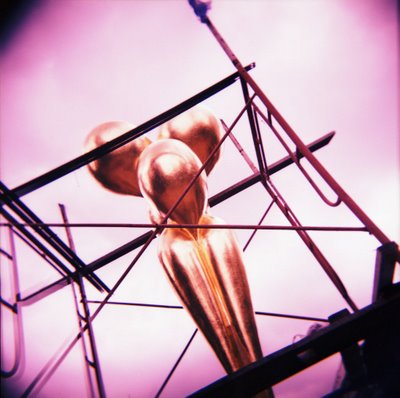
Chromatic aberration: Check
Vignetting: Check
Spot focus: Check
Under/overexposure: Check
It's a HOLGA!

If only the Russkies had nuked the Yanks in the 80's, we wouldn't have all these idiotic forums debating which camera has the least noise at 1600 ISO. For one, we wouldn't have internet but, more importantly, we would all be shooting pretty sorry excuses for a camera. Unfortunately, we'd know how crappy our cameras are because the party photographers would be shooting 35mm from captured Japanese stock while us deep-coal miners would have to settle for the mass-produced all-plastic Holga. Pictures from our vacations to the Black Sea would come back after a month at the lab followed by three months sitting on the desk of the regional head of the Photographic Ethics Bureau looking something like this:
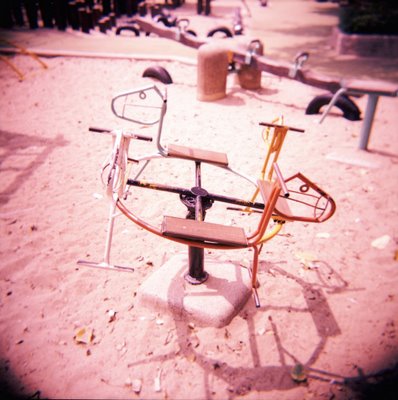
We wouldn't even be able to claim they are high-art and that the effects are intentional because millions of other factory-plant workers' vacation pictures would look just as bad. We'd tack the least worst one to the wall of our now sub-zero (August + 4 months = December) apartment in the suburbs of Putingrad and dream of next year's summer vacation, hoping it wouldn't be canceled due to compulsory "voluntary sacrifices and utmost dedication from all workers" in the arms race with China.
For real (fun ends here, comrades), our pictures wouldn't have to look quite as funky as these. These pictures were shot with Fuji Astia 100F and cross-processed. When the lab handed them over, I thought, "Yikes, it's all green. Where are the colors? And how come it's a negative. I gave them a slide film." (I'm very late on this whole project so the idea of having to get new film and re-shooting, with the friendly guys from Analog Memory waiting for me to give them back their cameras, was not pleasing at all.)
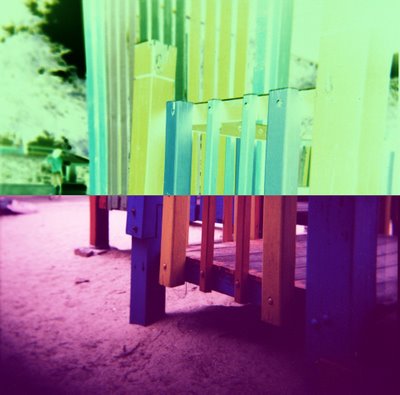
Once I loaded the reversal film turned negative into my awesome Epson 4990, I got a whole different story than from the old Epson at work. You can correct a lot during scanning because of the incredible bit depth of high-end scanners like the the 4990. I tried not to correct the pics too much because I like the original feel but see how almost all of the reddish cast is gone in the shot below:
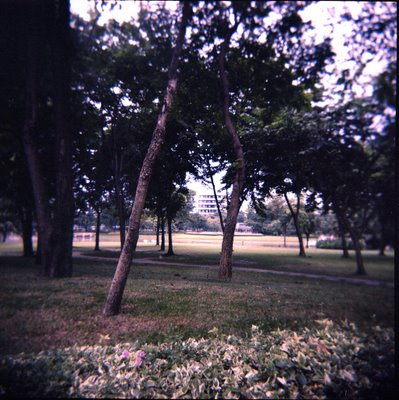
Cross-processing is using the wrong chemicals to develop your film. Since these pictures were shot with slide film, they were developed with the chemicals designed to process negative film. Different slide films will produce different results. These pictures don't have the famous "Lomo" look (yellowish/greenish cast) because Fuji Astia, when cross-processed, comes out exceedingly red/magenta. According to Analog Memory Fuji Velvia comes out really red and black (worse than this). So for the "Lomo" look, make sure you use Fuji Provia. I don't know about Kodak because I don't have Kodak film. Fuji gave me this film for free. They are nice. They will grow old and prosperous. Their families will be blessed for a thousand generations. Shoot Fuji and you too will receive these blessings.
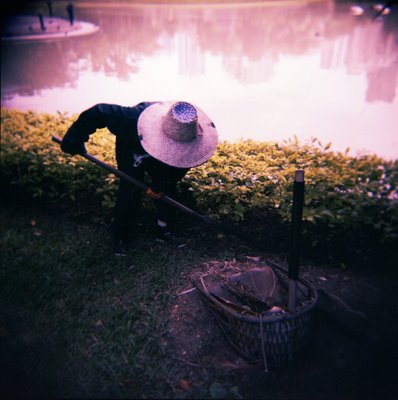
The fact that the slide film turned into a negative is normal. It's a product of the cross-processing. I find that fascinating because it means slide and negative film are fundamentally the same thing. They're just tuned differently to produce the right colors when processed with slide or negative chemicals. It's like activating a gene with a certain hormone or something. IQ Lab developed the film for free and the big boss even wrote to me to explain cross-processing in detail. Here's a summary of his letter:
"Color reversal (slide) film is normally processed in E6 chemicals. Color negative film is processed in C41 chemicals. Cross-processing is developing reversal film with C41 chemicals. The differences in film dyes (negative's bases, which have lower contrast, are usually dyed brown or orange to look good in print) create the shift in colors.Well thank you Khun Sompetch! This is the boss of the biggest pro lab in town with three or four addresses all over Bangkok and he took the time to write all that in English. Get your film processed at IQ Lab. They rock.
Most photographers choose to cross-process and pull-process together for more balanced contrast. Cross-processing increases contrast and pull-processing reduces it.
Pull-processing is over-exposing the film but then under-developing. This creates correct exposure with less contrast. For example, using Fuji Provia 100 film, set the ISO speed to 50 ISO on you camera. This will make it systematically over expose. Then come to lab and tell them that your 100 ISO film was shot at 50 ISO and we will perform one stop pull-processing.
Of course, you could cross-process and push-process.
Push-processing is under-exposing and over-developing. This increases contrast. Cross and push processing combined would create extremely high contrast that could be suitable for scenes in the shade with low contrast.
In the end, it's up to you and the best way to find what you like is to experiment. Different films will give different results.
Lomography is a stylish form of photography. Using a simple camera and an unusual developing process, images will appear eye catching. Sometimes these toy cameras suffer from extreme chromatic aberration and light dispersion but these are good effects for this kind of photography. Lomography is very popular with our clients here, along with giclee prints."
It's not obvious with this Fuji Astia 100F film used here but he's right that cross-processing can be way too contrasty in direct sunlight and I'd definitely push-process Fuji Provia 100F to get lower contrast if I ever try this again. You'll see what I mean later this weekend when I post the Lomo LCA/Fuji Provia 100F pictures.

I'm in love with the Holga. The pictures it produces are packed with emotion. My initial take on cross-processing and hip sovietnik junk cameras were that they were just gimmicks to help people devoid of artistic talent give an arty feel to their work. Well, maybe that is exactly what they are but it's mission accomplished as far as the Holga is concerned. There's a magic to it that definitely wouldn't be there if you took the same shots in digital or with a standard 35m SLR. I don't like a single digital shot I've taken in roughly two months with my 350D. I don't like a single shot I've shot in two years with my Sony DSC-P200. I really like some of the shots here. I think the Holga's lens has so much personality that the cross-processing is a bit overkill. I'd love to try it simply with the beautiful Velvia 100 ISO and normal processing.
Taking perfect digital pictures requires a LOT of skill and know-how (contrarily to what the camera makers would like you to believe) and bores everybody to death. Taking the cool and trashy pictures shown here from the Holga just took 2 rolls shot in 1 hour at the park. I never touched a Holga before in my life and I didn't have the manual. This camera takes no batteries and you don't even need to know how to read to use it. The lens has drawings of a bust, two people standing with a kind, a big group of people (like a wedding), and a mountain. Use these to focus the lens. For light, there are only two settings: sun or cloudy/shade/flash(if you have one). Point, shoot, enjoy. The viewfinder is simply a piece of plastic that gives a rough idea of the frame. It's not connected to the lens in any way.

What further stuns me is how bad the camera is. I mean, as a toy for bored hipsters, the quality is just perfect, but if this was the vacation camera of the masses, no wonder the masses got pissed off. This thing is total junk. It takes all the defects you'd find in a cheap third-party zoom, multiplies them by ten, and packs them into a single fixed focal lens. The older Holga even suffered from serious light leaks from the body and required to be taped shut every time you changed film. While the model I used here has a glass lens, most Holga cameras are all plastic so image quality should be worse with those. With the Holga 120GN, the very center of the shot does have ok sharpness.
Verdict:
Holga = cool + fun + art + easy
Tested at Benjasiri Park (Th. Sukhumvit, between Soi 22 and 24, BTS Phrom Pong) on Fuji Astia 100F medium-format film.
In Bangkok, Holga 120 CFN (all plastic) cameras can be found for 3,400 baht at Room Interior (3/F Siam Discovery Center, Rama I Rd.) and the Shop@TCDC (6/F Emporium, 622 Sukhumvit Rd.)
Big Thanks to:
Analog Memory, who lent me the Holga
Fuji, who gave me the film
IQ Lab, who processed it for free and K. Sompetch for his advice.
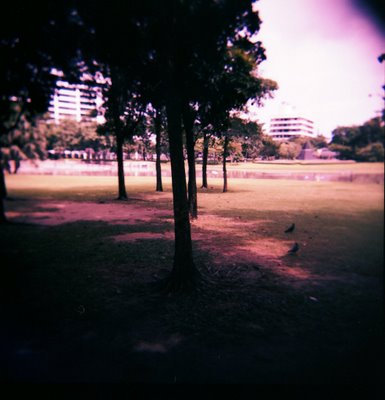

1 Comments:
You may have something there with this analog thing.
In the end, photography is about having an eye, imposing something on what you shoot, and NOT about faithful reproduction. Hence the allure of the fisheye, the panoramic, infrared and this Holga.
I must say I struggle everyday with unhappiness over what I shoot with my D70s. I've added lenses to my collection and while it gives me more options, I'm not sure it makes me happier. Strangely, I miss the coolpix even if I don't like the pictures I took with it, looking back. This is probably why I resort to B&W so much.
The risk is, tho, that one would tire of the 'look' after a while. Whether in one's one work or the countless others doing the same thing.
Perhaps that is what we yearn for, uniqueness, originality.
Imposing our vision on the viewer, not so much on the object we shot.
BTW, what's with that weird offset ghost effect on the first shot... it looks like you shot thru a piece of glass or a prism. Any idea how it ended up on the film?
Post a Comment
<< Home